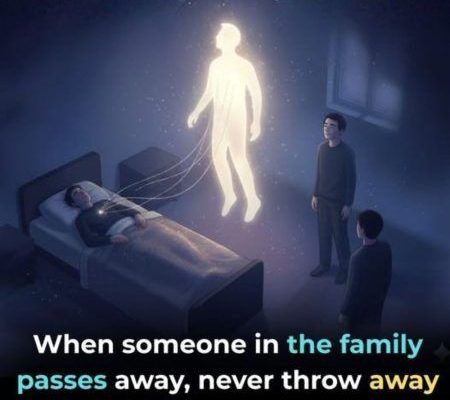Losing someone you love changes everything. It’s a hollow, disorienting kind of pain — one that makes even simple decisions feel unbearable. In the fog of grief, when you’re sorting through a loved one’s belongings, it’s tempting to move quickly. The silence feels heavier surrounded by their things. You tell yourself it’s just stuff, that holding on will only make it harder. But some items are far more than objects. They are pieces of history, carriers of memory, and links to the person you’ve lost.
There are a few things you should never rush to throw away — not because they have monetary value, but because they hold something you can never replace: presence, meaning, and love that lingers long after a person is gone.
1. Letters and Notes — Their Voice on Paper
In a world where most communication happens through screens, handwritten words have become rare treasures. A card signed in their familiar handwriting, a note scribbled on the corner of a grocery list, even a message written years ago can transport you instantly back to them. Letters and cards carry more than words — they carry tone, rhythm, and personality.
Maybe it’s the way they wrote your name, or how they ended every note with a heart or a small joke. Maybe it’s their handwriting, uneven and rushed, or graceful and neat — a reflection of who they were. These small fragments of ink preserve their voice. When grief feels overwhelming, reading their words can bring them close again, if only for a moment.
Even digital messages have meaning. Old emails, saved voicemails, or text conversations may seem ordinary now, but one day they’ll be priceless. They reveal a life — not the polished, public version, but the real one: affectionate, imperfect, human.
Keep them. Store them in a box or print them out. Because there will be days when you’ll want to remember how they spoke to you — and those words will become your lifeline.
2. Photographs — The Memory That Doesn’t Fade
Photographs freeze time in a way nothing else can. They don’t just show what someone looked like — they capture the energy of who they were in that moment. The laughter in their eyes, the way they held a coffee cup, the tilt of their head when they smiled.
It’s easy to underestimate their importance, especially when there are hundreds stored on your phone or computer. But the physical ones — the framed pictures on the shelf, the faded albums tucked away in a drawer — have a different weight. They tell stories you might forget otherwise.
Even photos of distant relatives or places long gone are part of a larger thread. They carry history. They remind you where you come from, and who you belong to. One day, future generations will look at them and see their roots reflected back.
If you can, organize them — label names, places, and dates. Make copies to share with family. Each photograph becomes a doorway, not just to the person who’s gone, but to the moments that made them who they were.
3. Heirlooms and Keepsakes — The Things Their Hands Touched
Objects can carry energy. They hold memory in a way that’s almost invisible but deeply felt. The wedding ring that never left their finger. The watch they wore every day. The sweater that still carries their scent. The recipe book marked with years of flour and fingerprints. These are not simply possessions — they are touchpoints of love and time.
An heirloom doesn’t need to be expensive to matter. A chipped mug can be more meaningful than a piece of fine jewelry if it reminds you of shared mornings and laughter. A kitchen tool used for family dinners, a book they read aloud to you as a child, or the blanket they always tucked around you — each one holds stories only you can tell.
Passing these keepsakes down to the next generation gives them new life. It keeps your loved one’s memory moving forward, carried through gestures, recipes, traditions, and everyday use. What once was theirs becomes part of your family’s rhythm — a reminder that love doesn’t end, it transforms.
4. Personal Documents — The Chronicle of a Life
Diaries, recipes, journals, certificates, or old letters of achievement might seem like paperwork, but they’re actually records of identity. They show how someone lived, what they valued, and what they created.
A diary reveals a private voice, a trail of thoughts and emotions that paint the truest picture of who they were. Even brief entries or lists can say so much — plans they made, worries they carried, hopes they never stopped believing in.
Recipes, too, hold emotional weight. A handwritten recipe for soup or pie might seem trivial, but every ingredient and note tells a story: of family gatherings, laughter in the kitchen, and shared love through food. These documents don’t just preserve facts; they preserve essence.
Certificates, awards, and mementos of work or service remind us that our loved ones had entire lives beyond the roles we knew — colleagues, creators, dreamers, people who tried and achieved and cared. Keeping those records honors their effort and keeps their story whole.
When Grief Makes Decisions for You
In the first waves of loss, practicality often takes over. You may feel the urge to clear everything out — not from coldness, but from survival. The sight of their belongings can feel unbearable, like reminders of a wound that won’t close. That’s normal. But decisions made in deep grief are rarely the right ones.
Instead, give yourself permission to pause. You don’t have to sort it all at once. Box up what you can’t face yet. Time will soften the ache, and when you’re ready, you’ll see those items differently. What feels like pain now may one day bring comfort.
There’s a quiet strength in keeping the tangible pieces of someone’s life. They are proof that they existed, that they mattered, and that their story continues through you.
The Legacy We Carry Forward
Grief changes shape over time. It doesn’t disappear, but it becomes woven into who you are. The things you choose to keep — the letters, the photos, the keepsakes, the documents — become part of that process. They aren’t anchors holding you in the past. They’re bridges connecting you to it, reminders that love isn’t erased by loss.
Every object tells a story. Every photo whispers, remember. Every letter says, I was here. And in keeping those small, sacred pieces, you’re saying, You still are.
When the years pass and memories begin to blur, these treasures will remain steady — reminders not just of who your loved one was, but of the bond you shared. Because in the end, love leaves evidence everywhere: in ink, in images, in worn fabric, in recipes and journals and songs.
And when you hold one of those items close, you’ll realize something powerful — they’re not just things you’ve kept from them. They’re things that have kept you whole.



